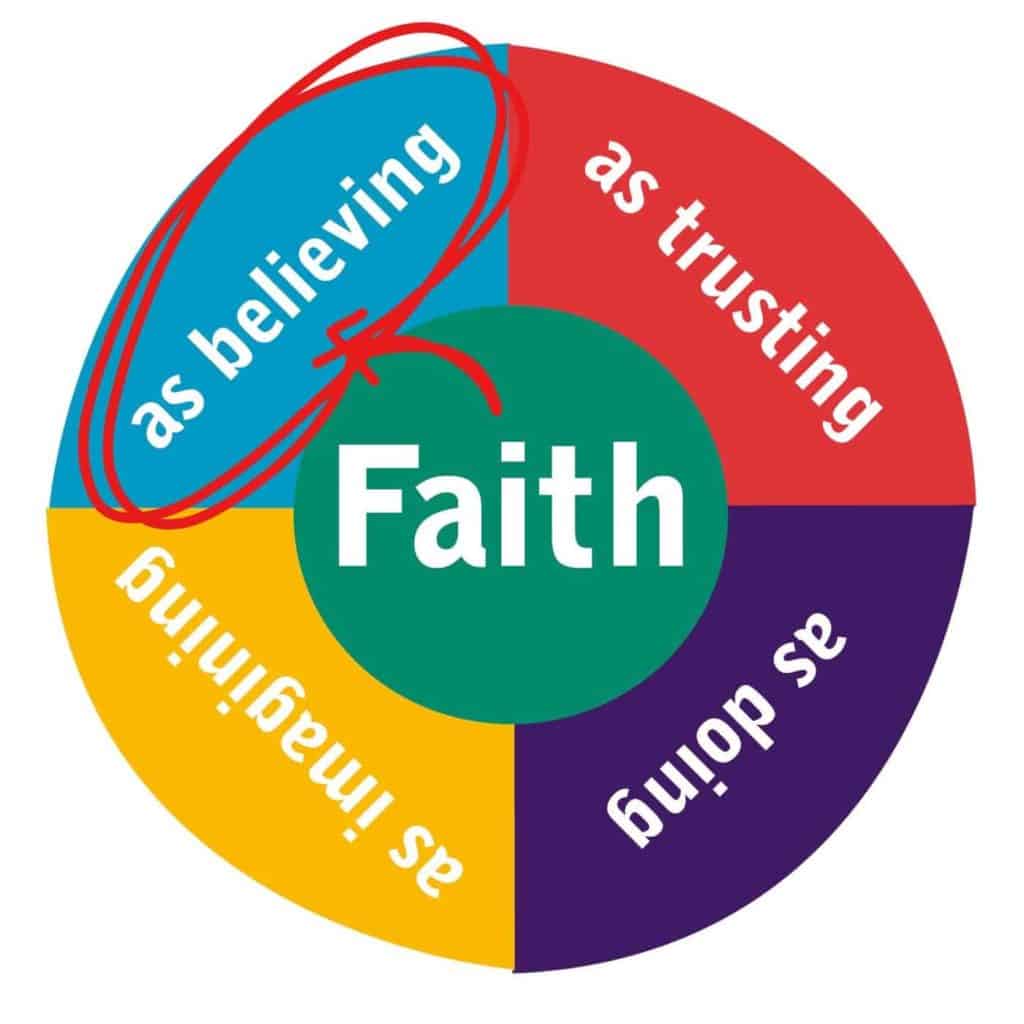
Faith as believing
In the book, Children Finding Faith, Francis Bridger says that faith can be seen in four Christ-centred dimensions: believing, trusting, doing and imagination. Having previously explored doing, I’d like to consider what we mean by believing and what we can do in our faith at home to grow our belief.
What we believe is so important. What we believe about ourselves will often limit what we are able to do. People who believe they could never run a marathon are unlikely to do so. People who believe themselves to be unlovable will often unintentionally behave in such a way which makes them difficult to love.
In the same way. what we believe about God plays a vital part in our faith. When it comes to faith at home, its essential that we feed our understanding of who God is to grow a stable, grounded faith.
I’ve recently been meditating on a collection of Bible verses about who I am in Christ. One of the things which has struck me is how all the statements are about God. It’s obvious really, but here are a few of the statements so you can see what I mean:
I am a child of God.
I am lavished with grace.
I am able to do all things through Christ who gives me strength.
I am God’s work of art.
I am redeemed.
I am wonderfully and fearfully made.
I am accepted and forgiven.
I am the pleasing aroma of Christ.
I am a branch of the true vine.
(For a full list, see GodVenture.co.uk)
I explored these and other statements with a group of adult Christians, getting the to look up a series of the verses, create the I Am saying from each, and then read them aloud. As he did so, one gentleman finished off by saying, “But I certainly don’t feel like it.”
It’s true that things in the Bible which we know in our minds to be true often don’t feel it, and I knew what he meant. Over a couple of months I’ve been doing a creative meditation, to help my mind absorb them and translate them from things I know into things I actually believe.
I’ve looked them up, written them out, and then have played with them in various creative ways, making word pictures and even a magnet set of them as a way of helping myself remember and ponder them. I’ve spent time thinking and praying, asking myself,
Which of these statements am I most comfortable with?
Which of these statements am I least comfortable with?
Which of these statements really doesn’t feel true?
In this way I’ve started to imbed some more Bible truth into myself.
This in some ways, belief the easiest part of our faith to understand and maybe to feed, as most of our Sunday church activities are set up for both adults and children to receive teaching so that we understand God better.
Of course, the four aspects of faith Bridger cites cannot really be separated, and so I often find that as we are building our knowledge, we are also using our imagination and also working out what this faith means for our daily activities, while also growing closer to Jesus.
For a growing knowledge about God to be useful to our faith, it needs to be intertwined with an increasing experience of God, a growing connection with Him. This is something Rachel Turner talks about in her book Parenting Children for a Life of Faith. I think it’s interesting that in many places in the Bible the word ‘know’, which we often associate with thinking, is often experiential. For example, Adam knew Eve and she conceived. That’s not book knowledge!!
. I think it’s interesting that in many places in the Bible the word ‘know’, which we often associate with thinking, is often experiential. For example, Adam knew Eve and she conceived. That’s not book knowledge!!
Francis Bridger says: “This emphasis upon faith as an intellectual activity has frequently been overplayed. But the importance of believing in doctrinal truths should not be understated.”
How can we feed this part of our faith?
1 Read or listen to the Bible together and choose your Bible wisely.
If you’re using re-told stories in a children’s Bible, check what the text and pictures are saying. I love ones where there’s nothing you’d have to unlearn later. I also love having lots of different children’s Bibles so that my children can see the different ways the stories are told, as this is the beginning of recognising that people read the Bible in different ways and have different theology. For older children, it’s helpful to use different Bible translations, as often what’s different can be really interesting!
When using a Bible to read together, try and find a good, accessible translation. My favourite for reading aloud is the Contemporary English Version (CEV), and for emerging readers, the New International Readers Version has shorter sentences and simpler language. (There’s a Large Print version of the New Testament NIrV available from Biblica which is the perfect size for new readers aged 5-10 years).
Think about opportunities to start introducing a ‘real’ Bible. For example, it’s possible to read a short passage for a 2 or 3 years old and it’s amazing how much they grasp from. From around 5 years old, we’ve listened to audio Bibles. We once listened to 15 chapters of Exodus in 2 days! I’d never have attempted to ‘read’ that much with them, but listening in the car was easy!
2 Create space to connect with God when reading the Bible.
You could ask God to speak with you before you start reading. You could use wondering questions afterwards such as:
I wonder what part of this story you liked most.
I wonder which part of this story was the most important
I wonder which part of the story jumped out at you.
I wonder what you discovered about God in this story.
I wonder what part of this story you have a question about.
I wonder where you might be in this story.
I’ve found by introducing open-ended questions to which I don’t know the answers and wondering aloud myself, my children are now confident to ask deep and complicated questions of the text. For example, the other day my 6-year-old asked why Jacob and his family didn’t return from Egypt to Canaan after the famine was over, thus avoiding slavery and the need for Moses and the Exodus. Good question!
By asking my own questions, my children know asking questions of the text is ok, and I’ve shown them how we can go about seeing if we can answer them, while also showing that sometimes we just don’t know the answer, and that’s ok too. This gives freedom to families to learn and grow together in their beliefs and allows for parents who are new to faith or feel they don’t ‘know much about God’ to still help their children grow in faith.
3 Use other books too.
We use non-fiction books like a Bible Atlas as well as books about Romans or Egyptians to help give us cultural context. We also use fictional re-tellings of the stories alongside the Bible text. I make sure my children know the difference between the two, and often the story drives us back to the Bible to find out more.
What could you do to grow your belief?

Last in this mini series: Faith as trusting
